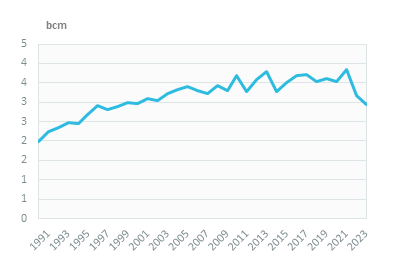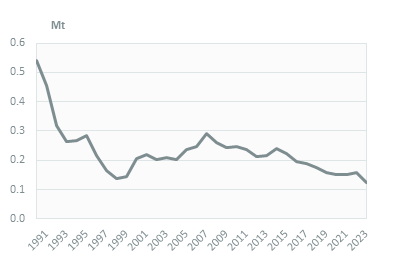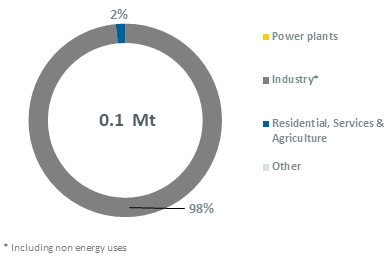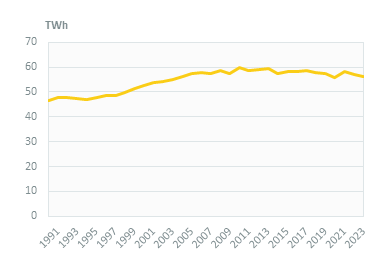-
-
 Energy and Climate Databases
Energy and Climate Databases- The most comprehensive and up-to-date annual energy database.
- Monitoring of technology providers in H2 supply chain.
- Monthly energy data on key energy markets.
- Monitoring of Hydrogen and Derivatives Projects
- The most reliable and up-to-date power generation database.
- The essentials of LNG trade at your fingertips.
- Global monitoring of new and existing refineries.
- Analyse energy consumption and efficiency trends at world level. Benchmark countries.
- Have your database developed by a recognised expert of both energy and IT.
-
 Energy - Climate Forecasts
Energy - Climate Forecasts- Future carbon costs with reliable price forecasts
- Instant access to energy and emissions forecasts.
- Annual projections of wholesale prices up to 2050, based on a 360° approach of the energy markets, enabled by the globally recognised POLES model.
- Wedges module showing a breakdown of the levers enabling to reduce emissions between two scenarios.
- Unique, independent projections of consumption by end-use.
- GHG Marginal Abatement Cost Curves.
- Benefit from proven models to draw your own energy scenarios and anticipate tomorrow’s challenges.
-
 Market Intelligence
Market Intelligence- 110 Energy and climate country reports.
- Tracking trends, EPCs, and national subsidy schemes for residential buildings.
- Daily brief covering the entirety of the turbine industry.
- A newsletter to receive the latest updates on evolving technologies and policies.
- Global energy news and analyses curated daily.
- Enerdata’s experts bring you the essentials about your market and competitors.
-
-
-
 Market Analysis
Market Analysis- Understanding key consumption trends and drivers across sectors.
- Granular and exclusive insight to address the most pressing business and strategic issues.
- Expertise in strategic and business intelligence, with fine-tuning to the market’s specificities.
-
 Energy - Climate Scenarios
Energy - Climate Scenarios- Providing the outlook of an energy commodity in mid to long term time horizons.
- Sector and driver specific energy demand forecasting.
- Assess the evolution of energy prices on the international and regional markets, as well as end-users prices.
- Enerdata guides you through pathways to reach climate targets.
- Supporting local authorities in their decarbonisation strategies.
-
 Climate Strategy and Policy Evaluation
Climate Strategy and Policy Evaluation- Cutting-edge quantitative tools and relevant indicators to monitor and evaluate evolutions on worldwide energy markets.
- Analysis of the most cost-effective options to reduce emissions.
- Quantified simulation and analysis of pledges for climate change negotiations.
- Breakdown of carbon markets and evaluation of the climate change impacts on the carbon price.
- Enerdata guides you on the most beneficial policy or investment options.
- Turning climate objectives into concrete action plans.
-
 Training
Training- Understand different policy targets and measures on energy efficiency.
- How to measure energy savings?
- Energy Forecasting is a 2 days training to learn to design and interpret energy forecasts.
- Energy statistics training allowing to create energy balance with supply, transformation and consumption and understanding the international energy statistics regulations.
- Initiation to EnerMED level 1is the training to approach on the most powerful energy demand forecasting model.
-
-
Resource Centre
Switzerland Key Figures
- Population:
- 8.85 million
- GDP growth rate:
- 0.72 %/year
- Energy independence:
- 57.2%
Data of the last year available: 2023
- Total consumption/GDP:*
- 62.3 (2005=100)
- CO2 Emissions:
- 3.56 tCO2/capita
- Rate of T&D power losses:
- 7.59%
* at purchasing power parity
View all macro and energy indicators in the Switzerland energy report
Switzerland Energy News
View all news, archive your new and create your own daily newsletters only on your topics/countries of interest with Key Energy Intelligence
Switzerland Energy Research
Benefit from up to 2 000 up-to-date data series for 186 countries in Global Energy & CO2 data
A data overview is available in the global energy statistics app
Switzerland Total Energy Production & Consumption
Total energy consumption per capita is 2.5 toe (9% lower than the European average in 2023), including 6 340 kWh/cap (18% higher than the European average) (2023).
Total energy consumption has remained roughly stable since 2021 (around 22.5 Mtoe). Previously, it decreased by 3.5%/year over 2019-2021, and increased slightly (around 1%/year) over 2016-2019.
Switzerland has the lowest energy intensity in Europe (behind Ireland and Malta) (2023) (at purchasing power parities).
Graph: CONSUMPTION TRENDS BY ENERGY SOURCE (Mtoe)
Source: Switzerland energy report
Interactive Chart Switzerland Total Energy Production & Consumption
Source: Global Energy & CO2 data
Benefit from up to 2 000 up-to-date data series for 186 countries in Global Energy & CO2 data
View the detailed fondamentals of the market at country level (graphs, tables, analysis) in the Switzerland energy report
Switzerland Oil Production & Consumption
Of total oil imports, 2/3 are made directly in the form of refined products (6.3 Mt in 2023) and 1/3 in the form of crude oil (2.9 Mt).
In 2023, 39% of crude oil imports came from Nigeria (+5 pp), 32% from the US, and 25% from Libya (+20 pp). Nearly 60% of the refined oil products are imported from Germany (-9 pp).
Source: Switzerland energy report
Interactive Chart Switzerland Crude Oil Production & Consumption
Source: Global Energy & CO2 data
Interactive Chart Switzerland Refined Oil Products Production & Consumption
Source: Global Energy & CO2 data
Benefit from up to 2 000 up-to-date data series for 186 countries in Global Energy & CO2 data
Additionally, for more detailed information on refineries, you can request a sample of our EMEA Refineries Dataset
Switzerland Natural Gas Production & Consumption
Gas consumption is deeply influenced by weather conditions since around two thirds of the consumption are used for heating purposes. It fluctuated around 3.6 bcm over 2010-2020 but increased by 8.6% in 2021 and then plummeted by 3.7%/year from 2021 to 2023, falling below 3 bcm, mostly due to a warmer winter and restrictions due to high prices.
Graph: NATURAL GAS CONSUMPTION (bcm)

Source: Switzerland energy report
Interactive Chart Switzerland Gas Production & Consumption
Source: Global Energy & CO2 data
Benefit from up to 2 000 up-to-date data series for 186 countries in Global Energy & CO2 data
Additionally, for more detailed information on the LNG trade, you can request a sample of our EMEA LNG Trade Dataset
Switzerland Coal and Lignite Production & Consumption
Coal consumption is very low (less than 0.15 Mt) and almost entirely consumed in industry.
Graph: COAL CONSUMPTION (Mt)

Graph: COAL CONSUMPTION BREAKDOWN BY SECTOR (2023, %)

Source: Switzerland energy report
Interactive Chart Switzerland Coal and Lignite Production & Consumption
Source: Global Energy & CO2 data
Benefit from up to 2 000 up-to-date data series for 186 countries in Global Energy & CO2 data
View the detailed consumption trends at country level (graphs, tables, analysis) in the Switzerland energy report
Switzerland Power Production & Consumption
Electricity consumption decreased by 1.7% in 2023 to 56 TWh, driven by a mild winter. Previously, it had remained quite stable over 2010-2021 at around 58 TWh (except a 2.6% decrease in 2020 due to Covid, followed by a 4.3% rebound).
Graph: ELECTRICITY CONSUMPTION (TWh)

The residential sector is the largest electricity consumer (34%); it is followed by industry and services (29% each) (2023).
Graph: ELECTRICITY CONSUMPTION BREAKDOWN BY SECTOR (2023, %)
Source: Switzerland energy report
Interactive Chart Switzerland Power Production & Consumption
Source: Global Energy & CO2 data
Benefit from up to 2 000 up-to-date data series for 186 countries in Global Energy & CO2 data
View the detailed consumption trends at country level (graphs, tables, analysis) in the Switzerland energy report
Switzerland GHG emissions and CO2 emissions
In its second NDC published in January 2025, the country set the goal to reduce GHG emissions by at least 65% by 2035 compared to 1990 levels (vs 50% in 2030 and 35% in 2025 in the previous NDC version).
Source: Switzerland energy report
Interactive Chart Switzerland CO2 emissions
Source: Global Energy & CO2 data
Benefit from up to 2 000 up-to-date data series for 186 countries in Global Energy & CO2 data
View the detailed consumption trends at country level (graphs, tables, analysis) in the Switzerland energy report